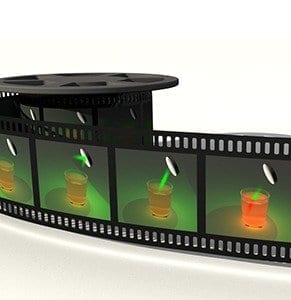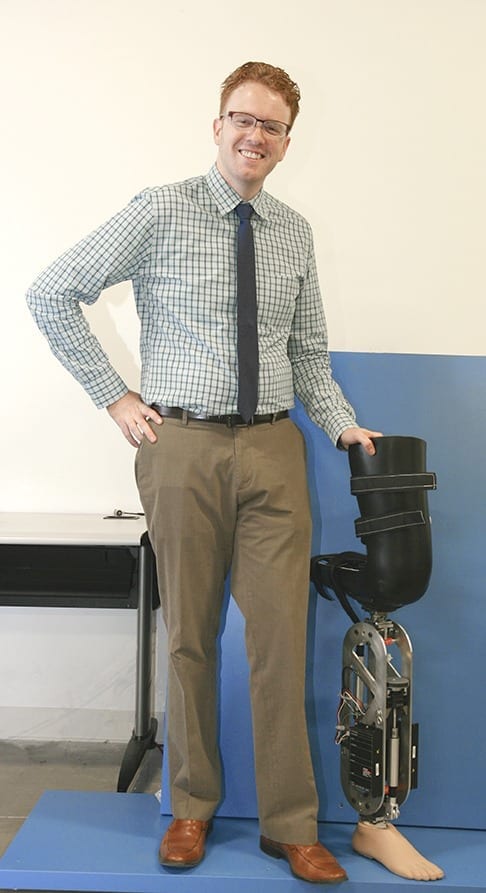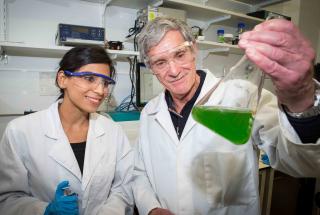
A team of biomedical engineers at Washington University in St. Louis, led by Lihong Wang, PhD, the Gene K. Beare Distinguished Professor of Biomedical Engineering, has developed the world’s fastest receive-only 2-D camera, a device that can capture events up to 100 billion frames per second.
That’s orders of magnitude faster than any current receive-only ultrafast imaging techniques, which are limited by on-chip storage and electronic readout speed to operations of about 10 million frames per second.
Using a technique developed at the School of Engineering & Applied Science called compressed ultrafast photography (CUP), Wang and his colleagues have made movies of the images they took with single laser shots of four physical phenomena: laser pulse reflection, refraction, faster-than light propagation of what is called non-information, and photon racing in two media. While it’s no day at the races, the images are entertaining, awe-inspiring and represent the opening of new vistas of scientific exploration.
The research appears in the Dec. 4, 2014, issue of Nature.
“For the first time, humans can see light pulses on the fly,” Wang said. “Because this technique advances the imaging frame rate by orders of magnitude, we now enter a new regime to open up new visions. Each new technique, especially one of a quantum leap forward, is always followed a number of new discoveries. It’s our hope that CUP will enable new discoveries in science — ones that we can’t even anticipate yet.”
This camera doesn’t look like a Kodak or Cannon; rather, it is a series of devices envisioned to work with high-powered microscopes and telescopes to capture dynamic natural and physical phenomena. Once the raw data are acquired, the actual images are formed on a personal computer; the technology is known as computational imaging.
The development of the technology was funded by two grants from the National Institutes of Health that support pioneering and potentially transformative approaches to major challenges in biomedical research.
“This is an exciting advance and the type of groundbreaking work that these high-risk NIH awards are designed to support,” said Richard Conroy, PhD, program director of optical imaging at the National Institute of Biomedical Imaging and Bioengineering, part of the NIH. “These ultrafast cameras have the potential to greatly enhance our understanding of very fast biological interactions and chemical processes and allow us to build better models of complex, dynamical systems.”
An immediate application is in biomedicine. One of the movies shows a green excitation light pulsing toward fluorescent molecules on the right where the green converts to red, which is the fluorescence. By tracking this, the researchers can get a single shot assessment of the fluorescence lifetime, which can be used to detect diseases or reflect cellular environmental conditions like pH or oxygen pressure.
Wang envisions applications in astronomy and forensics, where the advanced imaging frame rate could analyze the temporal activities of a supernova that occurred light years away, or track and predict the movements of thousands of potentially hazardous pieces of “space junk,” refuse of old satellites and jettisoned space craft hurtling about at high speed in outer space. In forensics, CUP might be used in reproducing bullet pathways, which could once again open up the Kennedy assassination conspiracy theories and revive a more accurate analysis of the strange physics of the “magic bullet.”
The Latest on: World’s fastest 2-D camera
[google_news title=”” keyword=”World’s fastest 2-D camera” num_posts=”10″ blurb_length=”0″ show_thumb=”left”]
via Google News
The Latest on: World’s fastest 2-D camera
- World’s Fastest Red Bull Drone Gives Best Ever View of Motorcycle Racingon April 26, 2024 at 4:02 am
A new drone from Red Bull is capable of flying at over 200mph, and can give better-than-ever views of motorcycle racing ...
- The best compact camera for 2024: top pocket choices to take anywhereon April 23, 2024 at 9:16 pm
Follow-up to the virally popular X100V – our previous top pick – it retains the fixed 23mm f/2 lens ... of the best vlogging cameras. Each entry has been tested in a range of real-world ...
- The 6 best tablets for business in 2024on April 21, 2024 at 4:30 am
If you need a tablet for business use, we're here to help. We've picked out all the best tablets for business encompassing different price ranges and needs.
- Insta360 X4 review: The only action camera you'll ever need is two in one?on April 16, 2024 at 6:00 am
The Insta360 X4 takes an already good device and makes it a whole lot better. Not only is it more responsive, but with the boosted resolution and mic compatibility it can now seriously be considered ...
- Best Camera 2024on April 12, 2024 at 7:30 am
Alternatively, you can record a 4K60p video with full 10-bit 4:2: ... the world of photography, a smartphone or a simple point-and-shoot camera featuring fully automatic operation is the best ...
- Insta360 could launch an 8K successor to the world's best 360 camera soonon April 12, 2024 at 4:44 am
Insta360 has announced a launch date for its next camera – and new leaks suggest it's for the Insta360 One X4.
- Major firmware for two key Fujifilm cameras, as the Kaizen updates commenceon April 11, 2024 at 11:11 pm
Fujifilm starts its Kaizen updates, with major firmware for the GFX 100 II and X-H2S, improving AF and adding features ...
- The Best Camera Phones You Can Buy in 2024on March 8, 2024 at 5:05 am
As the cliche saying goes, the best camera is the one you ... if you’re wondering why you’d want to zoom in on something far away. There is a vast world of wildlife, and a digital zoom is ...
- Watch the World's Fastest Camera Drone Chase an F1 Car at 200 MPHon February 27, 2024 at 12:16 pm
Red Bull and the nutty folks of Dutch Drone Gods recently came together to create the world's fastest camera drone ... but this time they'd have to race Max Verstappen behind the wheel of his ...
- World's Beston July 10, 2022 at 8:56 pm
You Can Now Vote in T+L's 2024 World's Best Awards Survey — for the Chance to Win $15,000 or a Cruise for 2 The World's Best Awards ... Hotels in Washington, D.C. of 2023 Travel + Leisure ...
via Bing News









